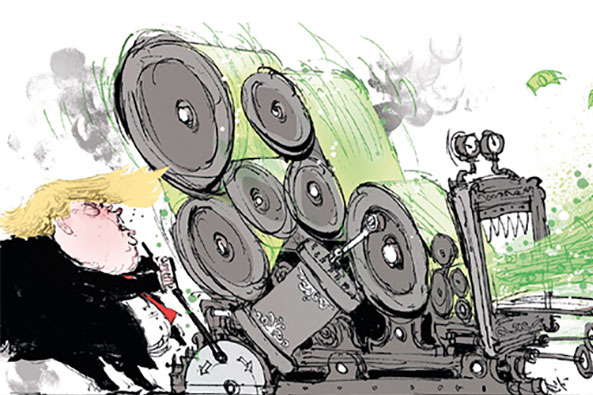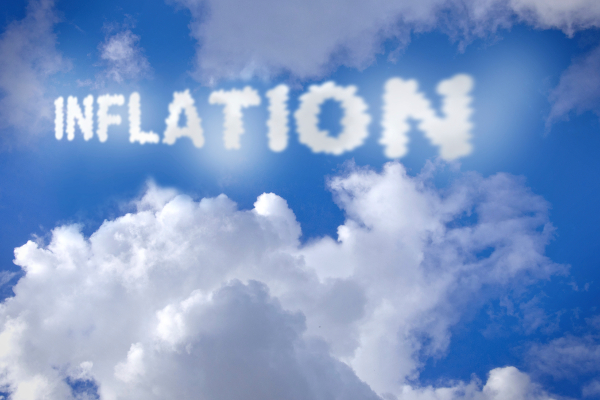Will the Covid-19 crisis and QE trigger the return of inflation?
A pandemic-induced rollback of globalisation raises the spectre of inflation - how worried should invest…
30th June 2020 10:46
by Tom Bailey from interactive investor
A pandemic-induced rollback of globalisation raises the spectre of inflation - how worried should investors be?

For most of the past 30 years, investors have been able to put inflation fears to the back of their minds. In what has been labelled ‘the great moderation’, the developed economies of western Europe and North America have enjoyed relatively low levels of inflation since the 1990s. However, there is growing concern that big changes brought about by the global coronavirus pandemic could spell the end of this low-inflation era.
At first, the prospect of inflation returning seems farfetched. Because of the coronavirus recession, we are seeing the opposite: CPI figures for advanced economies (including the UK) show very low levels of inflation. This makes sense, as the recession has caused consumer spending to collapse and unemployment to soar, while energy prices are at lows not seen for decades.
Indeed, the collective market wisdom is that we will not see meaningful inflation return any time soon. That’s significant because bond investors usually demand a yield that will provide a return above inflation. Andrew Cole, head of multi-asset at Pictet Asset Management, says: “Today, sovereign bonds are pricing in a long period of very low growth and low inflation, or even disinflation.”
- Bruce Stout on the dividend ‘reset level’ and deglobalisation
- Inflation falls to four-year low – will it ever start to rise again?
Globalisation reversal
However, some voices argue that the global pandemic could usher in an era of higher inflation once the initial deflationary pressure of the recession passes. Tom Stevenson, investment director at Fidelity International, says: “Coronavirus has accelerated many trends. This could include a potential reversal of the disinflationary environment that has characterised the past 30 or so years.”
One concern is that we will see a reversal of globalisation. Globalisation has allowed companies to produce goods relatively cheaply in low-wage economies, which has exerted downward pressure on workers’ wages in advanced economies. Moreover, it has allowed companies to create lean global supply chains by deploying highly specialised workforces to carry out each discrete part of their production process. This was Adam Smith’s pin factory on a global scale, and it led to cheaper production costs and lower prices.
However, these arrangements are increasingly being seen as a source of weakness rather than strength in the current circumstances. Tihana Ibrahimpasic, multi-asset analyst at Janus Henderson, notes that we may see “retreating globalisation as companies reliant on international supply chains reassess their commercial benefits in the new environment”.
And that could push prices up. As Mark Carney, former governor of the Bank of England, has pointed out, if globalisation is deflationary, deglobalisation should be inflationary.
However, there is reason to be sceptical about this argument. First, firms may prefer to stomach any increased production costs. Erick Muller, head of product and investment strategy at Muzinich & Co, a US-based bond asset management company, says: “It is unclear whether the extra costs will be absorbed by corporate margins or consumers.” Lower margins are a concern for investors, but they are not an inflationary concern. On top of that, any ‘reshoring’ of production will likely entail high-tech and highly automated factories, reducing the risk of wage-led inflation.

Quantitative easing quandary
Another fear is that the response of governments and central banks to this crisis could trigger an outbreak of inflation. As Philip Smeaton, chief investment officer at Sanlam Private Wealth UK, observes: “The recent crisis has forced governments and central banks around the world to spend and ‘print’ money at a radical rate.”
Principally, governments have expanded their quantitative easing (QE) programmes to unprecedented levels. QE entails central banks creating money to buy bonds from financial institutions, increasing the money supply. This is likened to printing money, which economic orthodoxy holds to be inflationary, because it supposedly increases the amount of cash in circulation for people to spend.
However, it is not a given that QE causes inflation. Such fears appeared in the wake of the global financial crisis when governments first used QE. But while asset prices rose, inflation remained benign throughout the 2010s. Richard Koo explained the phenomenon thus in his book The Other Half of Macroeconomics and the Fate of Globalization: “Most of the liquidity supplied by the central banks remains stuck in the financial sector, due to a lack of borrowers.”
After the financial crisis, poor consumer and business sentiment curtailed spending, so the increased money supply in the financial system did not enter general circulation and therefore did not lead to price inflation. Many economists believe consumers and businesses will once again be slow to start borrowing and spending. Fahad Kamal, chief market strategist at Kleinwort Hambros, says: “The central banks’ bazookas are much bigger this time, but so is the demand destruction being wrought across the global landscape.”
Others, though, point to fears of ‘debt monetisation’. By buying up government bonds, central banks provide direct financing to governments, essentially by printing money.
However, Sebastian Mackay, manager of the Invesco Global Targeted Return fund, is sanguine, arguing that the monetary policy aims simply to fill a void and can be reversed as the economy recovers. He points out that Japan has already trodden this path: it has extremely high public debt and its central bank’s balance sheet is in excess of 100%. Despite this, Japan’s inflation rate remains low.
According to UBS Global Wealth’s chief economist, Paul Donovan, in his book The Truth About Inflation, the essential point to grasp about QE and inflation is that “it is not printing money that causes inflation, it is printing too much money that causes inflation”.

Deflationary forces
Whatever the risk of QE and deglobalisation, there are plenty of reasons to think advanced economies will stay on the low-inflation track for a while longer.
Alongside globalisation, technological progress has been a principal reason for low inflation in recent years. David Coombs, head of multi-asset at Rathbones, says: “Greater use of technology tends to make our lives and factories more efficient, and generally lower costs. These trends seem likely to only be exacerbated by the pandemic and its aftermath.”
A specific example of this is the continued rise of e-commerce. As Yoram Lustig, head of multi-asset solutions at T Rowe Price, points out, online shopping means not only lower costs – because there is less need for physical stores, inventories and staff – but also that “customers are given more choice and the ability to compare prices”.
Demographics also determine inflation. Lustig notes that most advanced economies such as those in Europe are on a path to Japanese-style demographics, meaning shrinking and ageing populations. This was deflationary in Japan, and it may also be so in Europe.
So, while there may be structural trends towards inflation, some trends will lead to deflation. Which will prevail? Coombs concludes: “Exactly how these conflicting inflationary and deflationary forces will work themselves out is difficult to determine.”
- Gold is top-performing asset class as Covid-19 and inflation fears prevail
- Hundreds of savings accounts now beat inflation
Equities are the best option in inflationary times
If we see inflation climb, many investors are likely to opt for gold, the supposed pre-eminent hedge against inflation. Gold may have some role in a portfolio if inflation returns, but equities are probably still your best bet.
If prices rise rapidly, investors will need a return to outpace them, and historically equities have been the only asset class able to do this. Kamal says: “Equities generate the greatest returns and are thus better able to preserve the real value of an investment.” He adds that the annualised real return from equities (dividends reinvested) between 1900 and 2019 was 5.5%.
Even in the worst-case scenario of high and sustained inflation, equities can provide real returns. William Bernstein, in his book Deep Risk: How History Informs Portfolio Design, writes that while severe inflation can harm equity returns by damaging economies, “it has not always savaged them”.
He points out that Chile experienced a 33% annualised inflation rate, or a 508 million-fold price rise, between 1927 and 1996. However, Chile’s stock market still provided an inflation-adjusted return of 3% a year. Similarly, the stock market in Israel provided real price-only returns of 3% a year between 1957 and 1996, when inflation was running at 35% a year.
This article was originally published in our sister magazine Money Observer, which ceased publication in August 2020.
These articles are provided for information purposes only. Occasionally, an opinion about whether to buy or sell a specific investment may be provided by third parties. The content is not intended to be a personal recommendation to buy or sell any financial instrument or product, or to adopt any investment strategy as it is not provided based on an assessment of your investing knowledge and experience, your financial situation or your investment objectives. The value of your investments, and the income derived from them, may go down as well as up. You may not get back all the money that you invest. The investments referred to in this article may not be suitable for all investors, and if in doubt, an investor should seek advice from a qualified investment adviser.
Full performance can be found on the company or index summary page on the interactive investor website. Simply click on the company's or index name highlighted in the article.